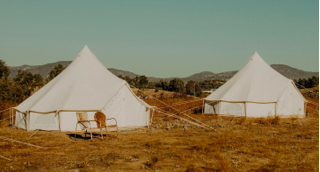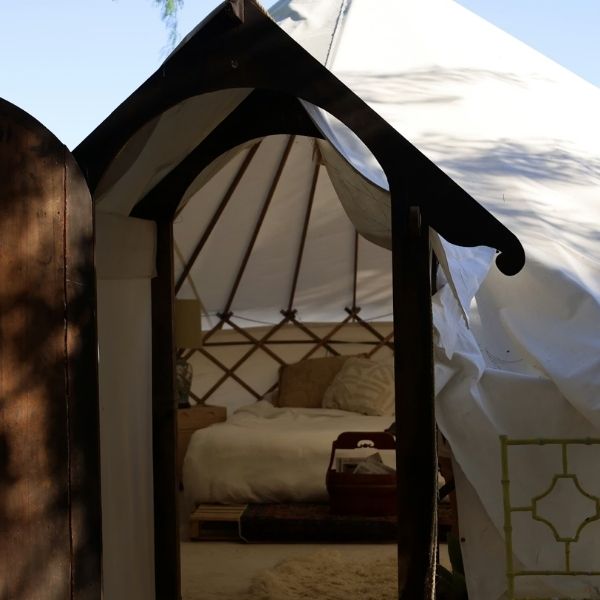Call Us: 1-971-220-8360
Free Shipping

Pay No Sales Tax
30-Month Warranty
Call Us: 1-971-220-8360
Tents
Shop


The LiT List
Glamping & Camping Ideas + Resources
Washing Your Sleeping Bag: A Step-by-Step Guide
5 min read
When’s the last time you washed your sleeping bag? Can’t remember? Then it might be due. Sleeping bags take on more abuse than you realize. You crawl in after late-night bonfires, leaving a smoky smell. You accidentally spill coffee on it after using it as a makeshift robe. And that’s not even touching on everyday sweat, body oils, and hair (both your pets and your own). However, since it’s likely been a while (or never?), you may need a refresher. Here’s a step-by-step guide for washing your sleeping bag.
The Steps for Washing a Sleeping Bag

In this guide, we offer easy steps for washing sleeping bags (both down and synthetic fillers), along with general cleaning tips to consider in between and before each wash.
General Cleaning Tips and Guidelines
Whatever sleeping bag you have – down or synthetic – there are universal tips and guidelines for cleaning and maintaining it.
- Follow the manufacturer's wash instructions. Use our general guide, but always verify the washing instructions provided by the manufacturer of the bag. It might have come with the bag’s sack, but if you’re still unsure, head to their website. That should have it!
-
Wash your bag sparingly. One thing to keep in mind about washing sleeping bags is that you should do it sparingly. Frequent washing can cause wear and tear on the bag and its filler over time. So, in order to avoid frequent washes, you need to maintain the bags’ cleanliness. Here’s how:
- Keep the shell off the ground. The best way to protect your outer shell is to add an additional layer between it and the ground to shield it from dirt and grime. This layer could include additional camp sleep gear, such as a sleeping pad, a camping cot, or a cowboy-style bedroll. In fact, bedrolls offer many features.
- Wash the interior lining separately. Sleeping bag linings provide an extra, sheet-like layer that protects the entire sleeping bag shell from becoming soiled or sweaty. A lining’s advantage allows it to be removed and washed separately and more often, prolonging the lifespan of the outer shell.
- Try spot cleaning. Spot cleaning is recommended for small stains located on the shell of your sleeping bag. Holding the shell liner away from the insulation, wash it with a mild soap detergent and a soft-bristled toothbrush, then rinse the suds off with a wet sponge or cloth. Then allow it to air dry after. Extra Tip!Spot cleaning is also a great first step before fully washing your sleeping bag.
- Use a commercial washing machine. If you forego the bathtub wash (steps for that are below) or lack a tub entirely, head to the laundromat. A front-loading washing machine is a must, but a spacious commercial front-loading washing machine is even better. Whatever you do, avoid top-loading washers that use an agitator column. That agitator style wash can damage a sleeping bag, entangling it and wrapping it around the column.

Steps for Washing Your Sleeping Bag in the Bathtub
Washing your sleeping bag in a bathtub is the preferred method for many types of campers and backpackers. One simple reason for this is that bathtubs hold more volume of water than the average home washing machine, giving your bag room to expand and really soak. Another reason is that it offers a gentler hand cleaning method.
- Fill the bathtub.Start by filling your tub with cool or warm water.
- Replace soap with gear wash. The key here is to replace average detergent with a technical gear wash cleaner specifically formulated for use on down. A few fantastic options are Nikwax Down Wash Direct and GearAid Revivex Down Cleaner. Either way, don’t go overboard, or you’ll be rinsing suds out forever.
- Unzip and add your sleeping bag. Place your unzipped bag in the tub and massage it into the soapy water. Look for stained areas and use a toothbrush to scrub, if you prefer, or simply rub the material together.
- Let the bag soak. Allow the sleeping bag time to air out. Up to an hour is recommended.
- Drain and squeeze. Drain the tub and squeeze the sleeping bag of excess soapy water.
- Rinse and drain again. Fill the tub with water (cool or warm) once more and gently massage out any remaining suds. Give the sleeping bag time to sit, then drain again. Repeat this step until you no longer see soapy suds when you squeeze out water.
Steps for Washing Your Sleeping Bag in a Washing Machine
It’s important to wash your sleeping bag properly. Otherwise, you can destroy a down’s fluff or mangle synthetic filler. You could also tear the outer shell. Using a front-loading washing machine and the right detergent can’t be stressed enough. If you can, a commercial washing machine is ideal.
- Add your sleeping bag.Place your bag into the washing machine drum. Zipped? There’s some debate here. Generally, unzipping means the interior gets better washed and rinsed and adds less stress on the zipper seams. However, if you prefer to keep it zipped, turn the bag inside out at least.
- Use a specific gear wash.Replace your average detergent and select a formula that suits your filler type. (See the Bathtub Steps above.)
- Choose a cold or warm water setting. Again, verify with the manufacturer. Take a moment to look around your bag for a tag. When in doubt, use a cold setting!
- Choose the gentle cycle and double rinse option. Set the cycle to gentle and give your bag a double rinse, maybe more. Any residue adds weight to the down, which results in a less lofty (and temperature rating-reducing) sleeping bag.
- Give a third rinse if needed. After the two-rinse cycle is complete, squeeze the sleeping bag to check the consistency. Feeling wet or damp is expected, but if it pools water or feels squishy, as if there are still suds, give it another rinse cycle.
- Squeeze out all excess water.Before removing the bag from the dryer, rotate it and squeeze out any trapped moisture.
Drying a Sleeping Bag
Drying your sleeping bag is equally important as washing it. Luckily, you have two options for drying: air drying, laid flat, and a low-heat tumble dry. Here’s how to do both:
- Scoop to remove. When transferring your sleeping bag out of the tub or washer, carefully scoop up the wet bag in your arms. Otherwise, the extra moisture weight could add stress to the seams and baffles, causing a tear.
- Lay the bag flat. Lay the sleeping bag out flat (on a clean surface). However, the trick here is to do so out of direct sunlight and in an area with low humidity. If the filler looks clumpy, fluff it out over time as the bag dries.
- Tumble dry on low heat. A second option is to add the bag to a dryer on a low heat setting. Synthetic sleeping bags will take roughly an hour or more. However, down-filled sleeping bags will require an additional hour or two of tumbling time.
- Combined method: Lay the sleeping bag flat until it’s mostly dry, finishing off with a low tumble to fluff it out and remove any remaining dampness.
Extra tip: Add clean tennis balls or (heavier) wool dryer balls to help re-fluff down bags.
Q&A: Can you dry sleeping bags in a home dryer? It’s possible, but a commercial dryer is highly recommended, especially if you find the sleeping bag balls up inside.
Maintaining Your Sleeping Bags

Treat your sleeping bag right, and it will continue to keep you dry, warm and cozy. Learn more about choosing a sleeping bag for camping, along with additional tips and accessories, such as a storage sack, that can protect your sleeping bag and extend its life for many years.
Related Resources

THE LIT LIST 4 min read
5 Reasons Yurt Tents Are the Ultimate Backyard Guest House
Hosting overnight guests? Consider a spacious backyard yurt tent as a spare guest room. Since many fHosting for the holidays or inviting overnight guests? Here are 5 reasons why yurt tents create the ultimate backyard guest room for your visiting family and friends. Affordable reason for selecting a yurt style tent for more permanent backyard glamping.

THE LIT LIST 2 min read
Black Friday Through Cyber Week Camping Tent Sales
Are you looking to save some money on purchasing a 2025 camping tent gift for that special someone? Popular Blogs
Camping Gift Ideas for People Who Have Everything
The Best Portable Tent Heaters - Ways To Heat A Canvas Tent
Glamping in Northern California: 8 Luxury Sites
Waterproofing A Canvas Tent - Retreating Canvas
33 Camping Quotes to Inspire Your Next Adventure
What Is Glamping? Origins, Definition, Destinations & More
10 Tips for Staying Warm While Winter Camping
How to Maintain and Clean a Bell Tent
Essential Family Camping Checklist: What to Pack [PRINTABLE]
Backyard Glamping Checklist for an Unforgettable DIY Glampsite
Popular Products
Subscribe
Sign up to get the latest on sales, new releases and tips
BECOME AN INSIDER
We’ll periodically share inspiration, bell tent releases, special offers, and event notifications with ya.



